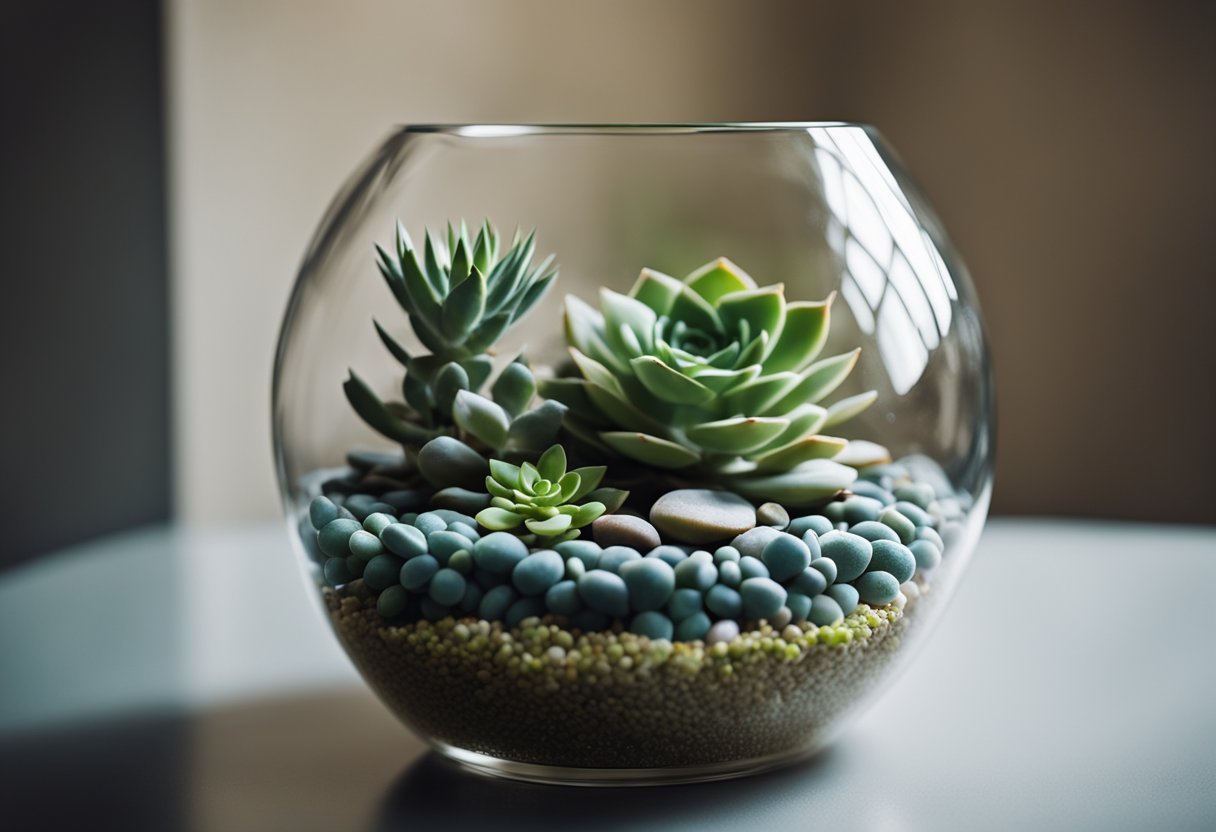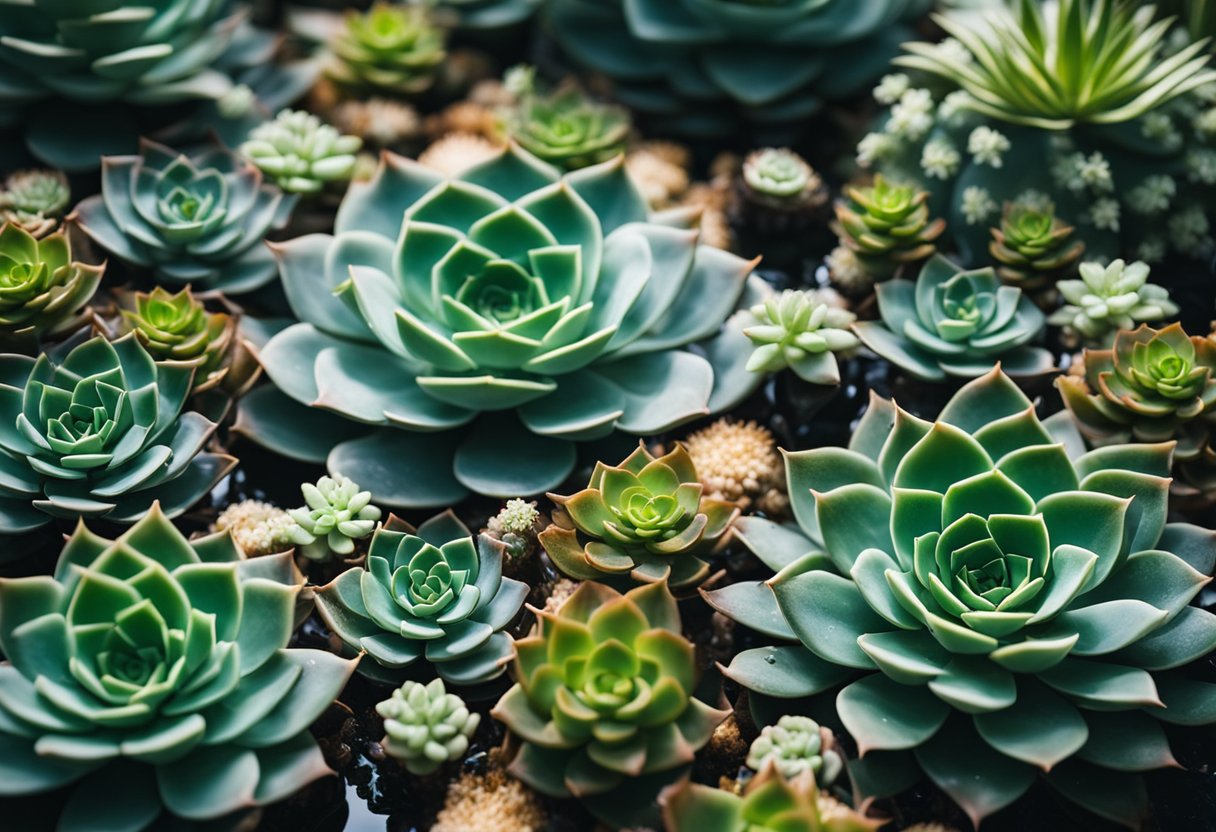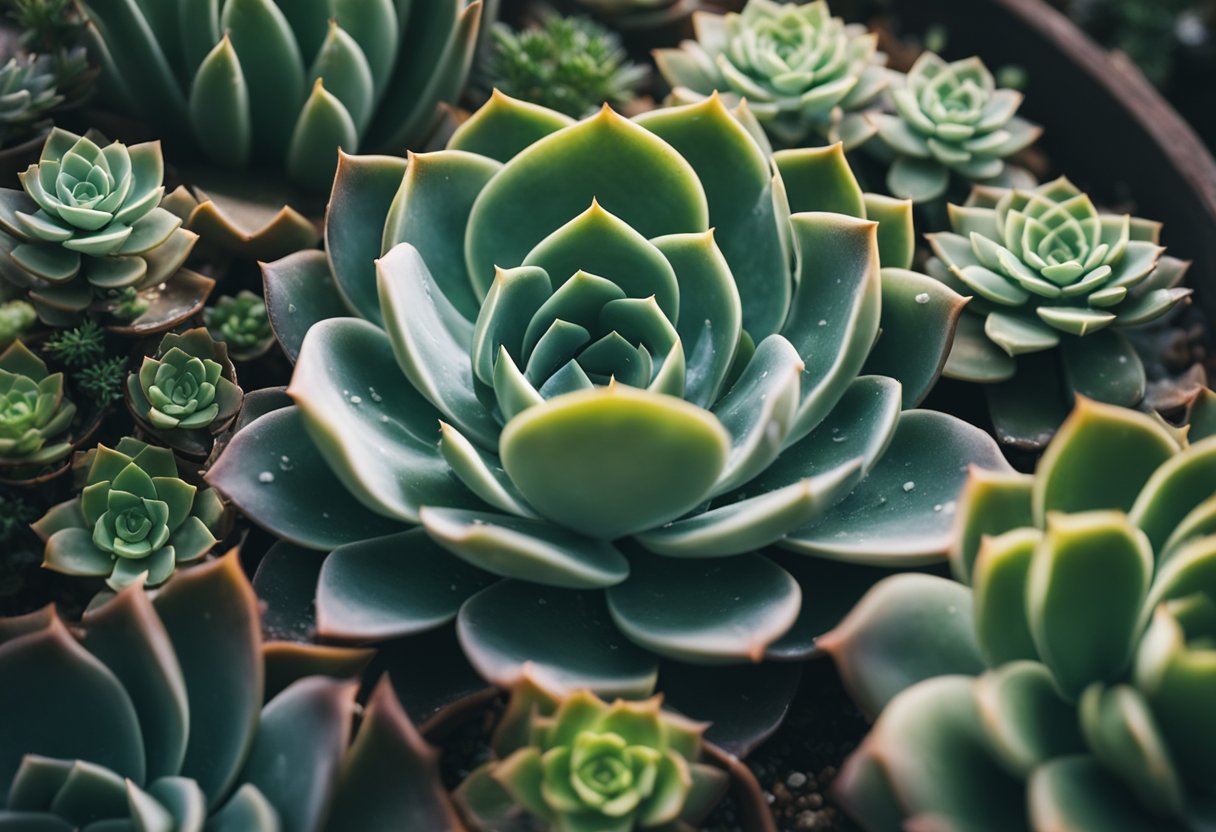Can Succulents Live in Water? A Comprehensive Guide to Growing Succulents in Water
Succulents are known for their ability to thrive in harsh and dry environments, making them a popular choice for indoor and outdoor gardening. However, many people wonder if succulents can live in water alone. The answer is yes, some succulents can survive in water, but not all.
This post may contain affiliate links, which means I’ll receive a commission if you purchase through my link, at no extra cost to you. Please read full disclosure here.

Succulents have adapted to store water in their leaves, stems, and roots, allowing them to survive in arid conditions. When grown in water, succulents can absorb the necessary nutrients and moisture through their leaves and stems, making it possible for them to survive without soil. However, it is important to note that not all succulents can live in water alone, and some may even rot if overwatered. It is essential to choose the right type of succulent and provide the proper care to ensure its survival.
Growing succulents in water can be a fun and unique way to display these beautiful plants. With the right knowledge and care, it is possible to create a thriving water garden of succulents. In the following sections, we will explore the types of succulents that can live in water, the benefits and challenges of growing succulents in water, and the steps you need to take to care for these plants.
Understanding Succulents

Succulent plants are those that have fleshy leaves and stems that are capable of storing water. This is a unique adaptation that allows them to survive in hot and dry environments where water is scarce. The term “succulence” refers to the ability of these plants to store water in their tissues.
Succulent plants come in a wide variety of shapes and sizes. Some of the most common types include cacti, aloe vera, and jade plants. These plants are typically found in regions with arid or semi-arid climates, such as deserts and savannas.
One of the key features of succulent plants is their ability to store water in their leaves. This is accomplished through a variety of mechanisms, including specialized cells that can absorb and hold water, as well as thick, waxy coatings on the leaves that help to prevent water loss.
In addition to their water-storing tissues, succulent plants also have a number of other adaptations that allow them to survive in harsh environments. For example, many succulent plants have shallow root systems that allow them to quickly absorb water when it is available, and also allow them to spread out and cover large areas in search of moisture.
Overall, succulent plants are fascinating and unique organisms that have evolved a wide range of adaptations to survive in some of the harshest environments on the planet. Whether you are a seasoned gardener or just starting out, there is always more to learn about these amazing plants.
Can Succulents Live in Water

Succulents are known for their ability to store water in their leaves, stems, and roots. This makes them well-suited for dry and arid environments where water is scarce. However, can succulents live in water?
The answer is yes, some succulents can live in water, but not all. Some succulents, such as the lucky bamboo, are naturally adapted to growing in water. Other succulents can survive in water for a period of time, but they may not thrive in this environment in the long term.
Water propagation is a popular method for propagating succulents. This involves placing the cuttings or leaves of a succulent in water until they develop roots. Once the roots have formed, the succulent can be transplanted into soil. However, it’s important to note that not all succulents can be propagated in water.
When growing succulents in water, it’s important to use the right type of water. Tap water can contain chemicals and minerals that can harm the succulent. It’s best to use distilled or purified water.
It’s also important to avoid overwatering succulents in water. Succulents are adapted to dry environments and can rot if they are exposed to too much water. It’s recommended to change the water every two weeks to prevent the growth of bacteria and algae.
In conclusion, while some succulents can live in water, not all can. Water propagation can be a successful method for propagating succulents, but it’s important to use the right type of water and avoid overwatering.
Propagation in Water
Succulents are known for their ability to store water in their leaves and stems, making them resilient to drought and low water conditions. But can succulents live in water? The answer is yes, with proper care, succulents can be propagated and grown in water. This method of propagation is called water propagation and it involves placing the cuttings in water until roots form.
Cuttings and Rooting
To propagate succulents in water, the first step is to take cuttings from a healthy plant. Use a sharp, clean scissors to gently snip around 2 to 4-inches of cutting with at least 1-2 leaves from a healthy portion of the stem, then carefully cut ¼ inches just below the node. You can remove some bottom leaves to further expose the stem. After doing so, it is very important to let the cuttings dry for a couple of days until the cut end has calloused or dried. This will help prevent rotting when placed in water.
Once the cuttings have calloused, place them in a container with water. It is important to use a container that will hold the plant in place and see through the container to make sure the stem isn’t touching the water. The cutting should hover just above the water. Place the container in a bright to medium lit area and wait for roots to form. It usually takes a few weeks for roots to form, but it can take longer depending on the species and environmental conditions.
Watering Schedule
When growing succulents in water, it is important to change the water regularly to prevent the growth of algae and bacteria. Change the water every week or two, depending on the size of the container and the number of plants. When changing the water, gently remove the cuttings from the container and rinse them with clean water. This will help remove any debris and dead plant material that may have accumulated in the container.
It is also important to monitor the water level and make sure the cuttings are not submerged in the water. The roots should be growing in the water, but the stem and leaves should be above the water line. If the stem is submerged in the water, it can lead to rotting and the death of the plant.
In conclusion, propagating succulents in water is a simple and effective method of growing new plants. With proper care and attention, succulents can thrive in water and produce healthy new growth. Keep in mind that not all succulents are suitable for water propagation, so it is important to research the specific species before attempting to propagate in water.
Caring for Water-Grown Succulents
Succulents can grow in water, but they require proper care to thrive. Here are some tips for caring for water-grown succulents.
Light and Temperature
Succulents need plenty of sunlight to grow properly. When growing succulents in water, it is important to place them in a location that receives bright, indirect sunlight. Direct sunlight can cause the water to evaporate too quickly, which can lead to dehydration.
Succulents also prefer warm temperatures, so it’s best to keep them in a room that is between 60 and 80 degrees Fahrenheit. Avoid placing succulents in areas that are too cold or too hot, such as near drafty windows or heating vents.
Humidity and Fertilizer
Succulents do not need a lot of humidity, but they do require some moisture to survive. When growing succulents in water, it’s important to change the water frequently to prevent the growth of bacteria and algae.
Fertilizing succulents in water is not necessary, but you can add a small amount of liquid fertilizer to the water every few weeks to provide extra nutrients.
Pests and Diseases
Succulents grown in water are less prone to pests and diseases than those grown in soil, but they can still be affected by issues such as root rot and fungal infections. To prevent these problems, make sure the water is clean and free of debris, and avoid overwatering.
If you notice any signs of pests or diseases, such as wilting leaves or discoloration, remove the affected plant immediately and dispose of it properly to prevent the spread of infection.
Overall, caring for water-grown succulents requires attention to detail and proper maintenance. By following these tips, you can help your water-grown succulents thrive and grow beautifully.
Potential Challenges
While succulents can survive in water, there are some potential challenges that growers should be aware of.
Overwatering
Overwatering is one of the most common challenges that succulent growers face. When succulents are grown in water, it can be difficult to determine how much water they are receiving. If the water is not changed regularly, it can become stagnant and lead to root rot.
Root Rot
Root rot can occur when succulents are left in standing water for too long. This can cause the roots to become waterlogged and begin to rot. To prevent root rot, it is important to ensure that the water is changed regularly and that the succulent is not left in standing water for extended periods of time.
Difficult to Revive
If a succulent has been grown in water for an extended period of time, it may be difficult to revive it if it is transferred to soil. This is because the roots may have become accustomed to water and may not be able to absorb nutrients from the soil.
Succulent Death
If the water is not changed regularly or the succulent is left in standing water for too long, it can lead to the death of the succulent. This is because the roots will begin to rot and the succulent will not be able to absorb the nutrients it needs to survive.
Overall, while succulents can survive in water, it is important to be aware of the potential challenges that come with this planting technique. Regularly changing the water and ensuring that the succulent is not left in standing water for extended periods of time can help prevent these challenges and ensure the success of the plant.
Types of Succulents that Grow in Water
Succulents are known for their ability to store water in their leaves, stems, and roots. While they typically grow in soil, certain types of succulents can also thrive in water. Here are some of the most popular types of succulents that can grow in water:
Echeveria
Echeveria is a popular succulent that can grow in water. These plants have rosette-shaped leaves and come in a variety of colors, including green, blue, pink, and purple. They are easy to propagate and can be grown from cuttings or leaves.
Sempervivum
Sempervivum, also known as hens and chicks, is another type of succulent that can grow in water. These plants have rosette-shaped leaves that come in a range of colors, from green to red to purple. They are easy to propagate and can be grown from offsets or leaves.
Cacti
While not all cacti can grow in water, some species can. For example, the Christmas cactus (Schlumbergera) can be grown in water. These plants have flat, segmented leaves and produce colorful flowers in shades of pink, red, and white.
Crassula
Crassula is a genus of succulent plants that includes a wide variety of species. Some of these plants can be grown in water, including the jade plant (Crassula ovata) and the string of buttons (Crassula perforata). These plants have fleshy leaves and are easy to propagate.
Sedum
Sedum is a large genus of succulent plants that includes many species that can grow in water. These plants have fleshy leaves and come in a range of colors and shapes. Some popular species include the stonecrop (Sedum acre) and the burro’s tail (Sedum morganianum).
Aloe
Aloe is a genus of succulent plants that includes many species that can grow in water. These plants have fleshy leaves and produce colorful flowers in shades of yellow, orange, and red. Some popular species include the aloe vera (Aloe barbadensis) and the cape aloe (Aloe ferox).
Agave
Agave is a genus of succulent plants that includes many species that can grow in water. These plants have fleshy leaves and come in a range of sizes and shapes. Some popular species include the century plant (Agave americana) and the blue agave (Agave tequilana).
Kalanchoe
Kalanchoe is a genus of succulent plants that includes many species that can grow in water. These plants have fleshy leaves and produce colorful flowers in shades of pink, red, and orange. Some popular species include the flaming Katy (Kalanchoe blossfeldiana) and the panda plant (Kalanchoe tomentosa).
In conclusion, while not all succulents can grow in water, there are many species that can. These plants are easy to propagate and can make great additions to any indoor garden.
Conclusion
In conclusion, succulents can survive and even thrive in water. This planting technique is known as succulent hydroponics. Succulents have fleshy leaves, stems, and sometimes even roots that can conserve water, making them adjusted to grow in hot and dry weather conditions.
Growing succulents in water can be an attractive way to display these houseplants. They can grow much more quickly than when grown in soil and can be easier to care for because they are not prone to diseases from the soil. However, it is important to note that succulents cannot be grown in dirty water as it will spread throughout the plant and can lead to discolored parts, stunted and irregular growth, or even death.
If you are a grower looking to propagate succulents, growing them in water can be a viable option. This can be done when propagating the succulent by cutting or offset. Once the roots have developed, the succulent can be transferred to soil for continued growth.
Overall, while growing succulents in water is possible, it is important to ensure that the water is clean and that the succulent is not left in standing water for too long. With proper care, succulents can thrive in water and make for a beautiful addition to any indoor or outdoor space.